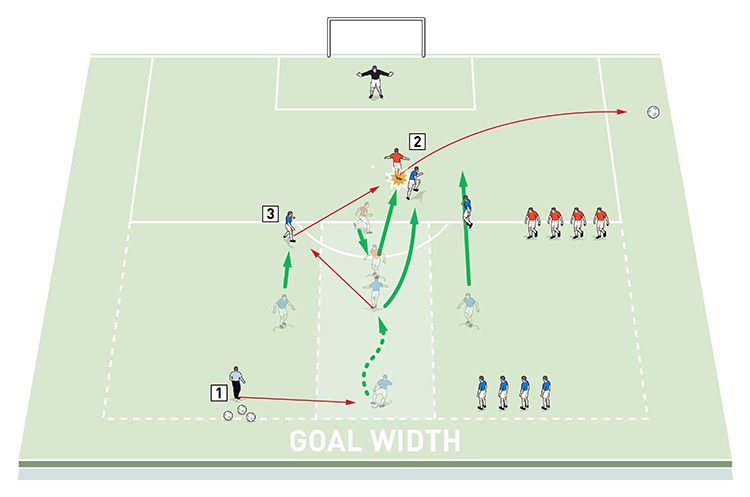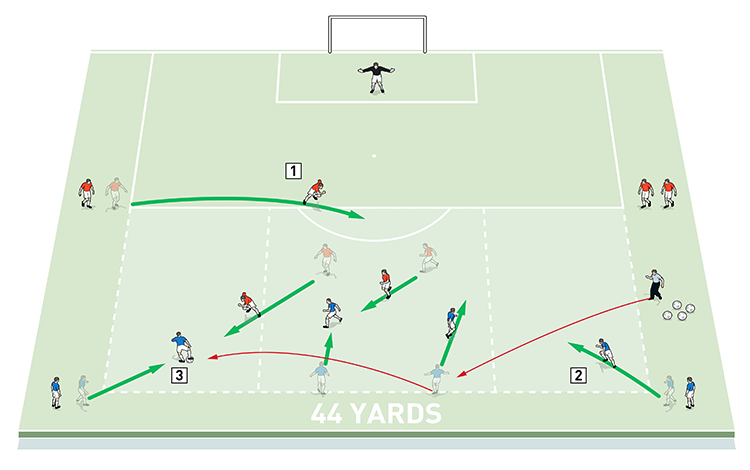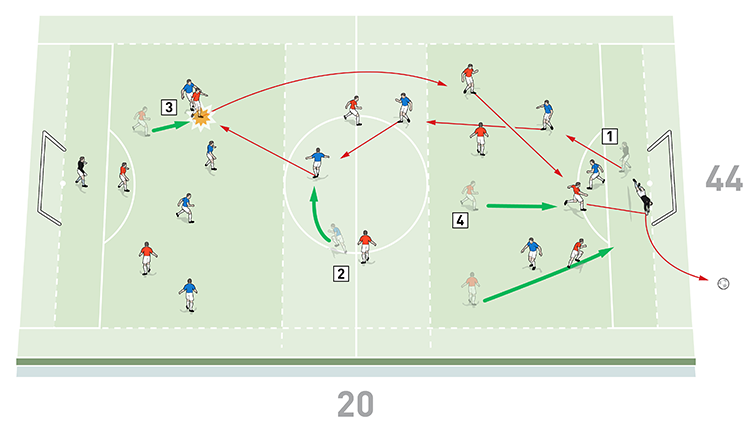You are viewing 1 of your 1 free articles
Defending 1v1 and against overloads
This training session is aimed at educating defenders in the skillsets, communication ability and decision making needed when they are goal-side of the ball and defending in either a 1v1 scenario or in an overload situation.
| Area | Up to three quarters of pitch |
| Equipment | Balls, bibs, cones, 2 goals |
| No. of Players | Up to 20 players + 2 goalkeepers |
| Session Time |
Defending 1v1, 2v1 & 3v1: 20mins, Defending 2v2, 3v2 & 4v2: 20mins, 10v10 game: 20mins |
This training session is aimed at educating defenders in the skillsets, communication ability and decision making needed when they are goal-side of the ball and defending in either a 1v1 scenario or in an overload situation.
In the modern game, when defenders are judged so much on their attacking instincts and on their qualities on the ball, sometimes the skill of defending is overlooked. But I believe that good, conscientious defenders actually pride themselves on the defensive aspects of their game.
This is a session that I would run fairly regularly but perhaps more importantly I would use it when we are due to face a team that plays in a more counter-attacking style, thus mirroring the type of situations that defenders will face at certain times during a game.
In this session defenders are put in situations where their decision making is important, so to get the best out of the players, coaches can make this session reward-driven by introducing a forfeit for the attackers or defenders that come off worst.
DEFENDING 1v1, 2v1 & 3v1
We set up in the final third of the pitch with a full size goal and a goalkeeper at one end and a central attacking channel the width of the goal marked with cones outside the penalty area. We’re using 12 outfield players split into seven attackers and five defenders, although numbers can vary depending on needs.
We start the session with the coach feeding a ball to the first attacker, who goes 1v1 against the first defender and tries to score in the goal.
The body shape of the defender is very important and he should get low and try to show the attacker onto the player’s weaker side if possible.
To progress the activity, two extra attackers can be added to the 1v1, with one placed on either side of the central attacking channel, making it first a 2v1 and then a 3v1. The additional attackers can only be used to bounce the ball off in order to help the main attacker get around the defender, as shown [1], but the defender mustn’t get beaten by wall passes and should not follow the ball – he should keep his attention on the main attacker at all times.
1

2. The first attacker goes 1v1 against the first defender, who should try to stop the attacker scoring
3. Progress by adding additional attackers who can be used for a bounce pass to help the main attacker get past the defender, making it first 2v1 and then 3v1
We play so each defender and attacker has three or four goes at the 1v1 before progressing the session every six minutes.
DEFENDING 2v2, 3v3 & 4v3
We progress the session further by increasing the width of the playing area. The size of the central attacking channel is now the width of the six-yard box.
We start by running a 2v2. The coach feeds a ball to one of the attackers in the central channel and the pair go up against the two defenders, who must try to stop the attackers from getting past them and scoring in the goal, as shown [2a].
2a

2. The coach feeds a ball to a pair of attackers in the central channel, who attack in a 2v2
3. The two defenders must try to stop the attackers from getting past them and scoring in the goal
After running the activity as a 2v2, we progress it first to 3v3 and then subsequently to a 4v3 attacking overload, as shown [2b], with the attacking channel now increased to the width of the penalty area.
2b

2. Add a fourth active attacker and then run it for six minutes with a 4v3 attacking overload
3. Here the outnumbered red defenders press successfully and have forced the attack out wide, where they have the chance to make it a 1v1
As the session progresses, the importance of communication grows and defenders have important decisions to make about when not to be passive. When the defenders are outnumbered, they have the opportunity to make it a 1v1 or a 2v2 in a wide area by forcing the play into these areas and their body shape and level of aggression should reflect this.
To progress the session further, the area size should increase each time an additional defender is added, although we never actually go to full width as we don’t want the distances to be too large – so it encourages the defenders to be brave and not passive. Another progression can be to add a single deep midfielder to supply the attackers, so the defenders can get caught out by runs in behind and have to react to the threat.
The coach should call obvious offsides and use plenty of praise when defenders get things right. Play each progression in blocks of about six minutes, constantly rotating personnel. After each block review what the players are seeing and learning.
10v10 GAME
We finish the session with a game. We set up a playing area between the penalty spots of the pitch with a goal and a goalkeeper at each end. We mark two equal-sized end zones either side of a 20-yard central zone.
We’re using 18 outfield players split into two teams of 10 including goalkeepers, with a 2v2 locked in the central zone and four attackers going up against three defenders in each end zone. This creates an attacking overload for each team at the end they are attacking and means the defenders have plenty of opportunities to implement what they have learnt in the session so far.
Play starts and restarts with a ball played from a goalkeeper to the defenders and play should be built up through the midfield, as shown [3].
3

2. It’s 2v2 in the central zone
3. Here the outnumbered defenders win the ball and launch a counter-attack
4. The team in possession has a 4v3 overload in the end zone it is attacking
What are the key things to look out for?
It is important to encourage the attackers to be bright and fluid in their movement and not just play and move in straight lines. Overlaps from the attackers are desirable in order to give the defenders decisions to make.
Defenders always have to be mindful of their body shape, their distances from one another and from the ball, and their communication with each other. They shouldn’t be passive and should always show they have an awareness of exactly where they are in relation to the goal and where they are on the pitch.
The goalkeepers also have a big part to play in the success of this training session, using clear communication with their defenders.
What are the typical mistakes players might make and how do I avoid them?
Typical mistakes that players might make include not recognising those key moments when attackers are vulnerable, whether that is by having a poor first touch, playing the ball on their weaker side, or being left isolated by poor movement made by their team mates.
Let defenders learn from their mistakes and give them time to get things right. As a coach, don’t always step in and correct things too early.
Related Files
Editor's Picks
Intensive boxes drill with goals
Penetrating the final third
Creating and finishing
My philosophy
Pressing initiation
Compact team movement
Defensive organisation
Back three tactics
Counter-pressing as an offensive weapon
Coaches' Testimonials

Alan Pardew

Arsène Wenger

Brendan Rodgers

Carlos Carvalhal

José Mourinho

Jürgen Klopp

Pep Guardiola

Roy Hodgson

Sir Alex Ferguson

Steven Gerrard
Related
Third phase overload and finishing pattern
Sunflower positioning
Attacking session utilising the overload
Coaches' Testimonials

Gerald Kearney, Downtown Las Vegas Soccer Club

Paul Butler, Florida, USA

Rick Shields, Springboro, USA

Tony Green, Pierrefonds Titans, Quebec, Canada
Join the world's leading coaches and managers and discover for yourself one of the best kept secrets in coaching. No other training tool on the planet is written or read by the calibre of names you’ll find in Elite Soccer.
In a recent survey 92% of subscribers said Elite Soccer makes them more confident, 89% said it makes them a more effective coach and 91% said it makes them more inspired.
Get Monthly Inspiration
All the latest techniques and approaches
Since 2010 Elite Soccer has given subscribers exclusive insight into the training ground practices of the world’s best coaches. Published in partnership with the League Managers Association we have unparalleled access to the leading lights in the English leagues, as well as a host of international managers.
Elite Soccer exclusively features sessions written by the coaches themselves. There are no observed sessions and no sessions “in the style of”, just first-hand advice delivered direct to you from the coach.








